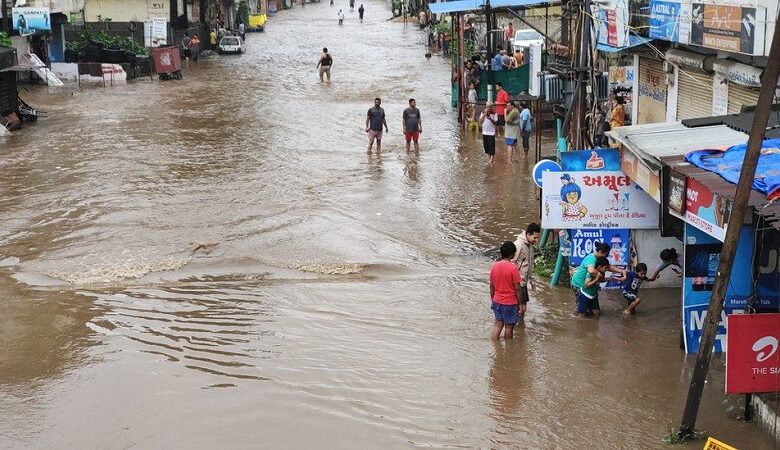Gujarat Battles Severe Flooding as Thousands Evacuated and Transport Disrupted

Gujarat, India, has been grappling with relentless heavy rainfall since Sunday, September 17th, resulting in the evacuation of approximately 11,900 residents from low-lying areas in various districts, including Vadodara, Bharuch, Narmada, Dahod, Panchmahal, Anand, and Gandhinagar. In addition to the mass evacuations, heroic rescue efforts have saved 270 stranded individuals, providing a glimmer of hope in the face of adversity.
Chief Minister Bhupendra Patel issued a statement acknowledging the challenges posed by the ongoing deluge. He emphasized the ongoing efforts to restore normalcy by clearing roads blocked by fallen trees, emphasizing the government’s commitment to safeguarding its citizens during this crisis.
The state of Gujarat finds itself grappling with the devastating impact of floods, with Ankleshwar town in Bharuch district emerging as one of the worst-hit areas. The National Disaster Response Force (NDRF) has been actively engaged in conducting rescue operations to assist those trapped by the rising floodwaters.
Among the major disruptions caused by the floods, train services on the crucial Mumbai-Ahmedabad route were severely affected. The situation became dire when the Narmada River swelled above the danger mark, particularly between Bharuch and Ankleshwar stations. As a result, train traffic along this route came to a grinding halt, stranding countless passengers.
However, there is a glimmer of hope for travelers, as Western Railway authorities announced a gradual resumption of train services around noon on September 18th, nearly 12 hours after the suspension. This decision was taken following a diligent assessment of the situation and the gradual receding of floodwaters.
The flooding in Gujarat has once again highlighted the vulnerability of certain regions to intense monsoon rains and the urgent need for robust disaster preparedness and response mechanisms. The state government, alongside central agencies like the NDRF, has been working tirelessly to mitigate the impact of the floods and ensure the safety of its residents.
The evacuation of over 11,900 individuals from low-lying areas underscores the proactive measures taken by authorities to prevent loss of life and minimize the impact of the disaster. Shelter homes have been set up to provide refuge to those displaced by the floods, offering essential amenities and support during this challenging time.
The heroic efforts of the NDRF in conducting rescue operations in the worst-affected areas have been instrumental in saving lives and instilling hope in communities affected by the deluge. Their dedication and expertise are a testament to the importance of well-trained disaster response teams in such situations.
Chief Minister Bhupendra Patel’s commitment to clearing roads blocked by fallen trees demonstrates the government’s resolve to restore normalcy and ensure that essential services can resume as swiftly as possible.
While the resumption of train services on the Mumbai-Ahmedabad route is a positive development, it also underscores the vulnerability of critical infrastructure to extreme weather events. The government must continue to invest in infrastructure that can withstand such challenges and develop comprehensive disaster management strategies.
As Gujarat battles the severe flooding, it is crucial for citizens to remain vigilant and heed the guidance of local authorities. Additionally, this disaster serves as a stark reminder of the need for climate resilience and sustainable urban planning to mitigate the impact of increasingly frequent and intense weather events.
News Mania Desk / Agnibeena Ghosh 19th September 2023






